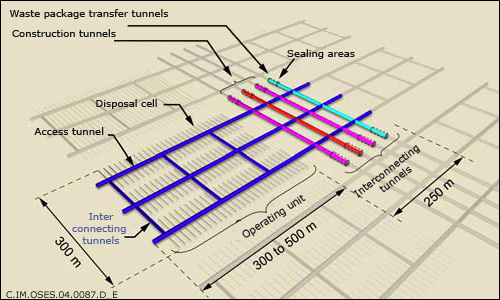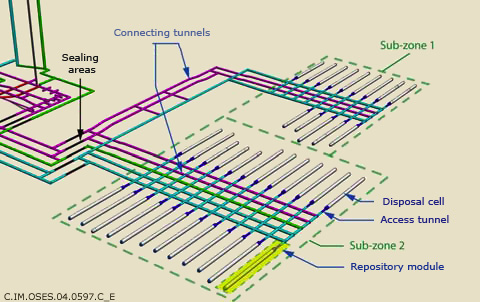CIGEO – Overview of a planned repository
The efforts made by engineers to ensure that highly radioactive waste buried deep underground will rest in eternal peace are reminiscent of the ingenuity of the ancient Egyptians tasked with ensuring that the Pharaohs’ tombs would be undisturbed. The term « repository » used to describe these large facilities clearly reflects this quest for permanence.
France has chosen to build a deep geological repository near the laboratory in Bure. Legislation passed in 2006 confirmed the choice of a site in a clay formation for a high- and intermediate-level waste repository. The CIGEO project arose out of this decision. It is the first step in a lengthy procedure. Following a public consultation exercise in 2013, technical files will be prepared by 2015. The disposal conditions – in particular regarding reversibility – will need to be stipulated by an Act of parliament. Only then will it be possible to submit a licensing bill to parliament. If the license is granted, operation could begin in 2025 with a pilot industrial phase to validate the design.
It is to be hoped that this process goes smoothly. Anti-nuclear associations are protesting against the location of the planned repository. The scientific community is at a loss to understand such a position, given that the purpose of such a facility is to minimise the impact of radioactive waste for future generations. What will they say if we leave them with the most radioactive waste packages on their hands? Near-surface interim storage, presented by some as an alternative solution, amounts to leaving our children to deal with our waste. We should bear in mind the words of Bernard Tissot, the first Chairman of the national assessment commission (Commission Nationale d’Evaluation – CNE): « excessive procrastination turns even the best interim storage facility into an awful repository ».

High-level waste repository
The area set aside for vitrified high-level waste is divided into a number of independent modules. Each module contains several dozen disposal cells. These disposal cells are reached via perpendicular access tunnels. The spacing between cells is designed to ensure that the heat released by waste is dissipated correctly. A similar architecture is planned for buried non-reprocessed spent fuel assemblies.
© ANDRA
Suitable geological formations are scarce resources that should be used to best effect. Rather than rejecting an essential solution, we should develop the means to reduce the volume of final waste requiring disposal. The legislative framework calls for research that will help us achieve this objective, by separating radioactive species, transmuting certain species and decreasing the weight of waste packages. If the goal of developing fast breeder reactors capable of burning plutonium is abandoned, stockpiled plutonium will have to be treated as waste. From a radioactive waste perspective, plutonium is an actinide. As spent reactor fuel contains 10 times more plutonium than minor actinides, several CIGEO repositories would be required to dispose of it all.
If the license is granted, the facility will be built in a 200 km² « transposition » area in the vicinity of the laboratory in Bure, in order benefit from the advantageous geological conditions. The task will be to identify a homogenous, fault-free volume of clay in the Callovo-Oxfordian, argillite rock formation approximately 500m underground. This volume should be of suitable size: approximately 2 km x 2 km and around 200 m thick.
The planned repository will be a very large facility extending over a surface area of several square kilometres. The underground facilities will consist of disposal cells excavated into the argillite formation, in which waste containers will be placed for disposal. These containers be waste packages like those currently produced at the plant in La Hague. There are currently no plans to modify existing waste packages.

ILW-LL (Intermediate level) waste repository
The intermediate-level long-lived waste repository would be divided into two sections, or sub-zones, one of which designated for waste packages containing organic matter, the other for packages that do not, such as compacted waste packages. The purpose of this distinction is to mitigate the consequences (in particular the release of hydrogen) of long-term decomposition of organic matter under the effect of radiation.
© ANDRA
ANDRA’s projects feature two separate filling zones for the two categories of long-lived waste currently earmarked for disposal: Vitrified high level waste (HLW) and intermediate-level waste (ILW-LL). An additional zone would be required for spent fuel assemblies, if it was decided to bury them.
Waste is stored on a single level located in the middle of the Callovo-Oxfordian layer, thereby maximising the thickness of impermeable argillite above and below it. Disposal cells are blind tunnels, which will be sealed after being filled. The access shafts are grouped together, to one side. The filling areas and the general architecture of the facilities form a dead-end configuration. The disposal cells are arranged such that the temperature of the rock in contact with the cells does not exceed 100°C. As a result, the disposal cells containing high-level waste, which releases heat, are spaced out.
For safety reasons, the cells are grouped together in independent modules. This organisation facilitates the site’s management and evolution. For example, one module may be filled while another is being built, taking advantage of previous experience. It should be borne in mind that building and filling such a facility is a process that will take decades, during which time technological progress may prompt changes to the nature and volumes of waste buried. The requirement for reversible disposal written into French law goes beyond the mere possibility of retrieving waste for a certain period. It also enshrines the principle of progressive, flexible management, leaving future generations free to make their own decisions.
Disposal cells will be sealed when they are closed. Trials using bentonite to seal cells are currently underway. Bentonite is a type of clay that swells upon contact with water. As it swells, the bentonite will exert pressure against the tunnel walls, helping to fill voids and plug cracks in the rock.
ANDRA video
– Virtual tour of the research laboratory in Bure (the virtual tour provides an overview of the laboratory using real-life images, as well as an introduction to the research carried out there): view video
Other articles on the subject « Geological disposal »
Waste duration
Nuclear spent fuel and vitrified waste: what legacy? « Much of this nuclear waste will remain haz[...]
Clay medium
The Callovo-Oxfordian argilite The geological stratum or ‘host rock’ that will[...]
Bure underground laboratory
A research laboratory for a disposal facility site Before high-level radioactive waste is buried [...]
Results on deep clay disposal
What we know about the disposal facility site In its final report in 2006 the French National Ass[...]
High-level waste repositories
Disposal of high-level waste packages The high-level waste packages requiring disposal will proba[...]
ILW-LL waste repositories
Filling an intermediate-level waste disposal cell Intermediate-level (ILW-LL) waste releases litt[...]
Waste disposal USA
Back to the drawing board after Yucca Mountain WIPP, the first deep geological repository to begi[...]
WIPP Project
The world’s first deep geological repository The United States is the first country in the [...]
Waste disposal Sweden
Sweden and Finland – Exemplary waste management Sweden probably features among the E[...]
Other countries
Shared challenges and similar solutions In most countries with nuclear industries, solutions for [...]